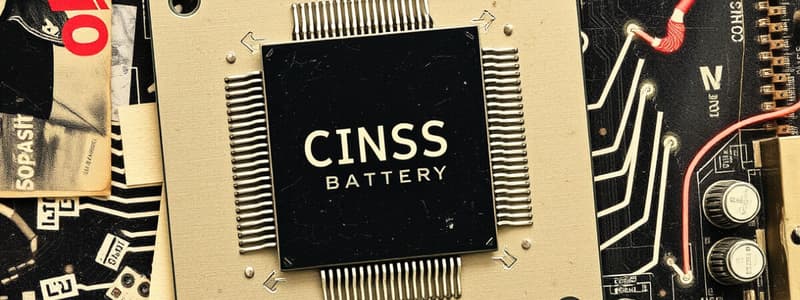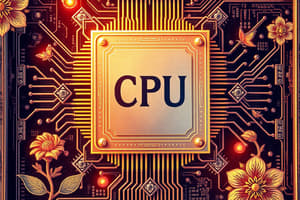Podcast
Questions and Answers
What does CPU stand for?
What does CPU stand for?
Central Processing Unit
What is the purpose of a CMOS battery?
What is the purpose of a CMOS battery?
To provide continuous power to the computer's real-time clock and maintain system BIOS settings.
What does a RAM slot hold?
What does a RAM slot hold?
A memory chip
What is a chipset?
What is a chipset?
What do SATA connectors connect?
What do SATA connectors connect?
What do IDE connectors connect?
What do IDE connectors connect?
What type of connector is an ATX power connector?
What type of connector is an ATX power connector?
What does the ATX 12 V power connector provide?
What does the ATX 12 V power connector provide?
What is the function of a fan connector?
What is the function of a fan connector?
What does the front panel connector do?
What does the front panel connector do?
What is eSATA?
What is eSATA?
Flashcards are hidden until you start studying
Study Notes
Central Processing Unit (CPU)
- Essential microchip that processes all instructions from user input or software.
- Requires cooling systems to manage heat generated during processing.
CMOS Battery
- Small lithium coin cell battery that powers the real-time clock and maintains BIOS settings.
- Average lifespan ranges from two to ten years.
RAM Slot
- Component that houses memory chips; common in end-user computers with two to four slots.
- Colored pairs indicate dual-channel memory configuration, promoting efficient performance.
Chipset
- Integrated circuit set that manages communication between the CPU and other components.
- Comprised of two main chips that facilitate data routing.
SATA Connectors
- Serial AT Attachment connectors that interface modern hard drives, SSDs, and optical drives with the motherboard circuitry.
IDE Connectors
- Integrated Drive Electronics connectors used for connecting hard disk and optical drives.
- Two IDE drives share one data cable; must configure one drive as master and the other as slave.
ATX Power Connector
- A 24-pin connector linking the power supply to the motherboard, delivering multiple voltage levels (3.3V, 5V, and 12V DC).
- Older models may feature a 20-pin connector, while very old systems use two six-pin connectors.
ATX 12V Power Connector
- A 4-pin connector providing additional 12V power from the power supply to the CPU.
- High-performance motherboards may require an 8-pin EPS 12V power connector for optimal functionality.
Fan Connector
- A three or four pin connector for CPU or case cooling fans, ensuring proper airflow and heat management.
- Common pin configuration: electrical ground, power, and sense output for fan speed monitoring; an optional control pin can adjust rotational speed.
Front Panel Connector and USB Headers
- System panel connector housing sockets for five crucial system cables: power button, reset button, power LED, hard disk activity LED, and internal speaker.
eSATA
- External SATA interface enabling the connection of external hard drives, SSDs, and optical drives to a computer.
Studying That Suits You
Use AI to generate personalized quizzes and flashcards to suit your learning preferences.




